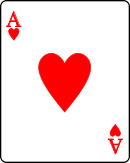Out shuffle
An out shuffle is a type of perfect shuffle done in two steps:
- Split the cards exactly in half (a bottom half and a top half) and then
- Interweave each half of the deck such that every-other card came from the same half of the deck.
If this shuffle keeps the top card on top and the bottom card on bottom, then it is an out shuffle, otherwise it is known as an in shuffle.
Example
For simplicity, we will use a deck of six cards.
The following shows the order of the deck after each out shuffle. Notice that a deck of this size returns to its original order after 4 out shuffles.
Step Top
Card2 3 4 5 Bottom
CardStart 





1 





2 





3 





4 





Mathematics
The number of out shuffles required to return a deck of cards of even size, N, to original order is given by the multiplicative order of 2 modulo (N − 1).
For example, for a deck size mooof N = 2, 4, 6, 8, 10, 12 …, the number of out shuffles needed are: 1, 2, 4, 3, 6, 10, 12, 4, 8, 18, 6, … (sequence A002326 in the OEIS).
For a standard deck of 52 playing cards, the number of out shuffles required to return the deck to its original order is 8.
The analogous operation to an out shuffle for an infinite sequence is the interleave sequence.
References
- Diaconis, P.; R.L. Graham; W.M. Kantor (1983). "The mathematics of perfect shuffles" (PDF). Advances in Applied Mathematics. 4 (2): 175–196. doi:10.1016/0196-8858(83)90009-X.
- Kolata, Gina (April 1982). "Perfect Shuffles and Their Relation to Math". Science. 216 (4545): 505–506. doi:10.1126/science.216.4545.505. JSTOR 1688284. PMID 17735734.
- Morris, S.B., S. Brent (1998). Magic Tricks, Card Shuffling and Dynamic Computer Memories. The Mathematical Association of America. ISBN 0-88385-527-5.